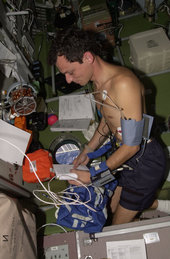Uncovering mechanisms behind human adaptation in different physiological and neurological systems
Human spaceflight induces physiological changes in astronauts that mirror symptoms associated with some very significant medical conditions affecting society such as osteoporosis and cardiovascular disease. Understanding such mechanisms and testing potential countermeasures in astronauts can therefore provide insights into associated earth-based conditions and provide the basis for improved treatments and rehabilitation. For this reason this area of research for ESA naturally aligns with the global goal of ‘Good Health and Well-Being’ specifically to ‘Strengthen the capacity of all countries, in particular developing countries, for early warning, risk reduction and management of national and global health risks’. Previous ESA research has a very solid foundation and has uncovered many different mechanisms behind human adaptation in different physiological and neurological systems. This is a great foundation for ESA’s current research and future research potential. Research into osteoporosis: Osteoporosis is a disease affecting millions of elderly people. In the EU in 2010 alone the treatment cost of osteoporosis, including pharmacological intervention, was estimated at €37 billion with additional costs to society estimated to bring this total up to €98 billion. Osteoporosis research can be effectively studied in space, because astronauts experience effects that are very similar to the disease, but in a much accelerated way. The research is carried out by multidisciplinary teams both on ISS, in bed-rest studies and using animals. The focus is on testing the latest physical and pharmaceutical countermeasures, and developing fundamental understanding of the processes leading to the disease. From previous ESA research strong indications have been found that osteoporosis can be linked to high salt intake, which affects the acid balance of the body as well as bone metabolism. Reducing salt (sodium) intake or using alkalizing agents may therefore be good countermeasures against the disease, both in space and on Earth. In addition a US company involved in the ESA ERISTO project used data from space experiments on mice in the formulation of an osteoporosis medicine (Prolia) now available on the market. Improving Asthma Diagnostics Research on breath composition in space has ‘rewritten the textbooks’ on the assumed effect of gravity on lung ventilation. The research has helped in the development of diagnostic tools, which quantify airway inflammation, and could improve the diagnostic use of exhaled nitric oxide on Earth for patients with asthma or other airway inflammatory diseases. Improving Medical Technologies and Quality of Life Furthermore in neuroscience, microgravity causes changes to the vestibular system which maintains our body’s balance and orientation, and leads to a decrease in visual tracking ability. The Eye Tracking Device used in previous ESA research is now used during eye operations and for enabling Amyotrophic Lateral Sclerosis patients to communicate with their eyes.


